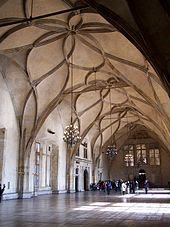We set off in the early morning for Prague Castle, though there is so much to see there I feel we only scratched the surface, and we intend to go back tomorrow. The castle complex dates from the 9th century, and I'm told is listed in the Guinness Book of Records as the largest ancient castle in the world.
Although the construction of the first walled building was in 870 AD, you won't find many examples of such early building, as the current ground level is well above what it would have been then. What you see is a real hodgepodge of architectural styles, with virtually every architectural style of the last millennium. It includes the Gothic St Vitus Cathedral, the Romanesque Basilica of St. George, Renaissance palaces, Baroque Palaces and Neoclassical style wings.
There are three courtyards and several streets. An ornate entrance gate at the Castle Square leads to the first courtyard, decorated with large sculptures of fighting pagan Gods and Titans.

The third and largest courtyard is dominated by the enormous St Vitus Cathedral, started in 1344 but not completed until the 20th century.

It is so enormous there seems to be no way of getting a decent photograph. It isn't open on Mondays, so we intend to go back tomorrow to see inside it, and perhaps see some other things as well. There is a magnificent 14th century mosaic and a clock, but I'm limited to the number of photos I can easily post, so I might manage some of those tomorrow if we go back.
The courtyard opens up into St George's Square, where you will find the Basilica of St George.

This was built in the twelfth century and replaced an older, tenth century church. The façade was added in the seventeenth century. Our Czech guide told us the the two towers were of unequal sizes because they represented man and woman, so they are called the Adam and Eve Towers.
In the same square you also find the Royal Palace, also known as the Old Palace. Romanesque and Gothic stories were built on the remains of the first, ninth-century structure. The biggest part you can visit is Vladislav Hall, built in 1493. Unfortunately, this is a place you have to pay to photograph, and we had not yet visited an ATM so we couldn't pay anything! The photo here comes from the Internet, and I hope it isn't too small to see, as it's quite impressive.

The last place we visited in the Castle was Golden Lane. Originally, there was just a wall behind Prague Castle. In the 15th century, the first very modest houses were built along it. As the original name of the street was Goldmakers Lane, it is thought most of the first inhabitants were probably goldsmiths. These houses were demolished in 1591. Six years later, Emperor Rudolph II allowed the 24 Prague Castle´s fusiliers to build their houses there, and because the area is small, the houses were tiny.
Later, various craftsmen and servants lived in the houses. According to local legends, Emperor Rudolph II had some of his court alchemists accomodated in Golden Lane, where they tried to turn metal into gold, so that could also be the origin of the name Golden Lane.
One of the more famous ones was number 22.

Frank Kafka lived here for two years, 1916 - 17, as he was looking for a quiet place to write. At the beginning of the 20th century, the owners of the houses became aware of their unique charm and many moved elsewhere to more comfortable apartments and opened their tiny Golden Lane houses to tourists, charging a fee. Others let their houses to writers or artists who were looking for inspiration.
Perhaps the saddest one is the little house of the psychic who called herself Madam de Thebes. She was a widow who could never believe that her son, who was killed in the First World War, was never coming back, and set the table for him every day.

She became a fortune teller and card reader, but her constant predictions of the end of the Second World War and the fall of the Third Reich led to her arrest by the Gestapo and she was tortured to death.
On that happy note, we left the castle and descended an interminable number of steps to the Lower Town at the foot of the hill. So I'll continue that in the next post.
- Posted using BlogPress from my iPad
No comments:
Post a Comment